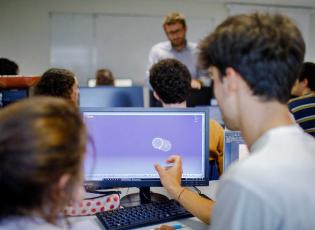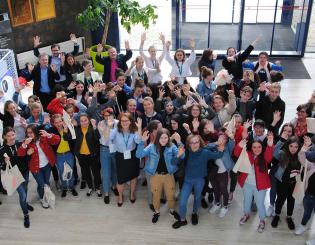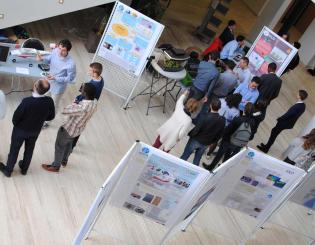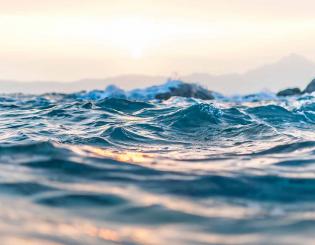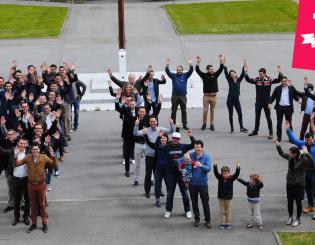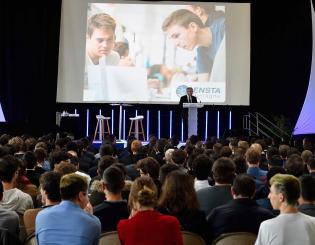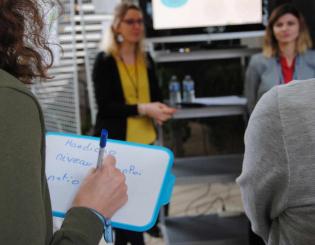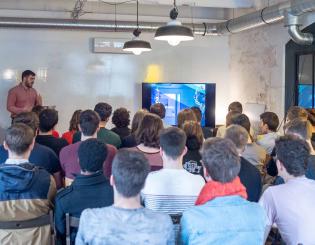
Student services fee (CVEC)
A compulsory fee
To obtain proof of payment
- Create an account or connect to your existing account on MesServices.Etudiant.gouv.fr (French-language site)
- Enter your personal data and state your city of study: Brest
- Pay the CVEC fee or declare yourself exempt (see conditions for exemption below)
- Download your proof of payment
- Upload it to your personal online space (Aurion)
Who has to pay this fee?
Students required to pay this fee:
- students enrolled in initial training who are not eligible for exemptions
- students on a gap year (no exemption)
- international students who pay tuition fees in France
- students on a co-operative engineering course
- students on a foreign government scholarship (BGE). This concerns all students, including those taking a co-operative engineering course.
The following students are exempt from paying this fee (but must obtain a certificate of proof):
- students on a Crous (Regional Center for Student Affairs) grant, subject to furnishing the Crous notification
- students on a French government scholarship (BGF)
- students with refugee status
- students who are beneficiaries of subsidiary protection and temporary protection
- students with asylum seeker status.
Students to whom this fee does not apply:
- international exchange students in France (Erasmus type scheme) who do not pay any tuition fees
- students enrolled in continuing professional development (e.g.: apprenticeship contracts)
- IETA military engineering students
Where do I submit my proof of payment?
When you receive your 2023–2024 proof of payment, you must upload it to your personal online space (Aurion).
ECTS Grading system
60 credits are the equivalent of a full year of study or work. In a standard academic year, 60 credits would be usually broken down into several smaller components.
A typical "first cycle" (or Bachelor's) Degree, consists of 180 credits, whereas a typical "second cycle" (or Master's) Degree, consists of 120 credits.
ENSTA Bretagne’s Engineering Programme involves 30 ECTS per semester and 60 ECTS per year, the Engineering Diploma corresponding to a third year of BSc (=60 ECTS) followed by the equivalent of a Master’s Degree (=120 ECTS).
The ECTS Grading scale
The grade distribution table below shows how the existing institutional scale is being used. It represents the statistical distribution of positive grades (pass and above) awarded in each field of study
| ECTS Grade | % of successful students normally achieving the grade | Definition | |
|---|---|---|---|
| A | 20 % | OUTSTANDING | |
| B | 30 % | VERY GOOD | Above average standards, with minor errors |
| C | 30 % | GOOD | Generally sound work, with some errors |
| D | 15 % | SATISFACTORY | Fair, but with significant shortcomings |
| E | 5 % | SUFFICIENT | Performance meets minimum criteria |
| FX | FAIL | Extra work required before credit can be awarded | |
| F | FAIL | Considerable further work is required; involves re-attendance of classes |
Local Grades
Local Grades are awarded on a scale of 0-20 (pass mark 10)
| Local Grades | Definition |
|---|---|
| 18≤n≤20 | OUTSTANDING |
| 16≤n<18 | VERY GOOD |
| 14≤n<16 | GOOD |
| 12≤n<14 | SATISFACTORY |
| 10≤n<12 | SUFFICIENT |
| Below 10 | FAIL |
MSc Marine Engineering Program
SEMESTER 1 - 1st YEAR: 3 course units (CE), 30 ECTS
| CU 3. 1 - Core subjects for mechanics | Lessons (55 minutes) | Anglais | ECTS |
|---|---|---|---|
| Mathematics | 36 | X | |
| LL1 English | 28 | ||
| Finite Elements | 48 | ||
| TOTAL | 9 |
| CU 3. 2 - Basics in naval architecture | Lessons (55 minutes) | Anglais | ECTS |
|---|---|---|---|
| Mechanical Engineering | 32 | ||
| Introduction to Resistance to headway |
12 | ||
| Naval structure basics | 12 | X | |
| Ship stability | 18 | ||
| Wing lift theory | 22 | ||
| Turbulence et couches limites | 26 | ||
| CFD Case Studies | 12 | ||
| TOTAL | 11 |
| CU 3. 4 Project | Lessons (55 minutes) | Anglais | ECTS |
|---|---|---|---|
| Project management - Intercultural management | 20 | ||
| Systems Engineering (courses) | 8 | ||
| Systems Engineering (tutorials) | 20 | ||
| Field Application Project | 80 | X | |
| TOTAL | 10 |
SEMESTER 2 - 1st YEAR: 4 CU, 30 ECTS
| CU 4. 1 - Core subjects for mechanics | Lessons (55 minutes) | Anglais | ECTS |
|---|---|---|---|
| Composites & nanocomposites | 21 | ||
| Plates and Beams | 21 | ||
| Vibrations | 42 | ||
| TOTAL | 8 |
| CU 4. 2 - ANO | Lessons (55 minutes) | Anglais | ECTS |
|---|---|---|---|
| Case study: wing theory | 16 | ||
| Introduction to the Finite Volume Method | 12 | ||
| Non Linéarité Géométrique | 26 | ||
| Fundamental principle of dynamics and notion of added masses and inertia | 4 | ||
| Wave theory and integral methods | 36 | ||
| Turbulence - LES method | 8 | ||
| TOTAL | 9 |
| CU 4. 3 - Project | Lessons (55 minutes) | Anglais | ECTS |
|---|---|---|---|
| Project: Naval Hydrodynamics (Choice_1) | 36 | ||
| Project: Naval Structure (Choice_1) | 36 | ||
| Sailboat project (Choice_2) | 36 | ||
| Floating wind turbine project (Choice_2) | 36 | ||
| Project RORO 1 - Resistance to headway |
16 | ||
| Projet Flambement d'éléments de structures | 12 | ||
| Projet Arrangement général, Stabilité et coupe au maître | 28 | ||
| TOTAL | 11 |
| CU 4. 4 - Languages | Lessons(55 minutes) | Anglais | ECTS |
|---|---|---|---|
| LL1 English | 14 | ||
| TOTAL | 2 |
SEMESTER 3 - 2nd YEAR: 4 CU, 30 ECTS
| CU 5.1 - Core subjects | Lessons (55 minutes) | Anglais | ECTS |
|---|---|---|---|
| Offshore and Naval Platforms | 52 | X | |
| Ship design Loop | 80 | X | |
| TOTAL CU 3.1 | 9 |
| CU 5.2 - ANO Basics in naval architecture | Lessons (55 minutes) | Anglais | ECTS |
|---|---|---|---|
| Seaworthiness | 22 | ||
| Resistance and Propulsion | 30 | X | |
| Maneuverability | 10 | ||
| Seakeeping | 4 | ||
| Naval structure | 66 | X | |
| TOTAL | 9 |
| CU E 5.3 Languages | Lessons (55 minutes) | Anglais | ECTS |
|---|---|---|---|
| Languages | 24 | ||
| TOTAL | 3 |
| CU 5.4 - Profiles | Lessons (55 minutes) | Anglais | ECTS |
|---|---|---|---|
| AOM | |||
| Common Lectures on Offshore Platforms | 40 | X | |
| Offshore Platforms for marine renewable energies | 92 | X | |
| Platforms for the Oil&Gaz Industry | 92 | X | |
| SNA | |||
| Common Lectures on Naval structure | 66 | ||
| Fatigue | 8 | ||
| Advanced Naval Structures (your choice) | 58 | ||
| Sailboat Design (your choice) | 66 | ||
| HNA | |||
| Common Lectures on Hydrodynamics | 66 | ||
| Sailboat Design (your choice) | 66 | ||
| Advanced Naval Hydrodynamics (your choice) | 66 | ||
| TOTAL CU 5.4 | 7 |
SEMESTER 4 - 2nd YEAR: 2 CU, 30 ECTS
| CU 6.1 Project | Lessons (55 minutes) | Anglais | ECTS |
|---|---|---|---|
| Project | 132 | ||
| TOTAL CU 6.1 | 5 |
| CU 6.2 PFE ANO | Lessons (55 minutes) | Anglais | ECTS |
|---|---|---|---|
| End-of-year project | |||
| TOTAL | 25 |
The classes marked with an * in this page are suitable for English speakers (course material and/or teaching in English). The candidate’s level of language should enable him or her to follow classes taught in French and English. A minimum level of B1 is recommended in both languages. All students may take their exams in English.
The courses and ECTS listed in this page are for information purposes only. They are liable to change in line with company expectations. These developments are part of the continuous improvement plan. ENSTA Bretagne has receveived the ISO 9001 accreditation for all its activities.







